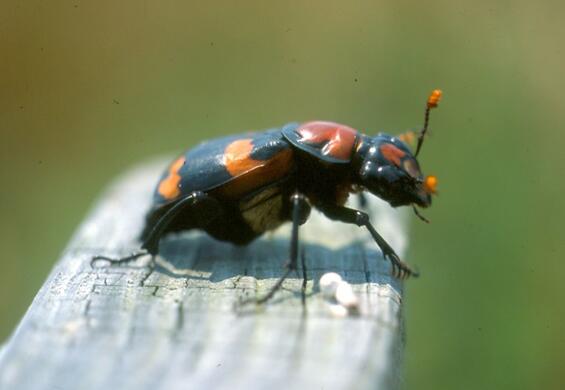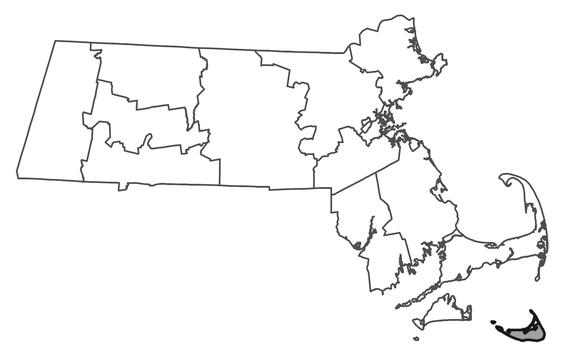- Scientific name: Nicrophorus americanus
- Species of Greatest Conservation Need (MA State Wildlife Action Plan)
- Endangered (MA Endangered Species Act)
- Endangered (US Endangered Species Act)
Description

American burying beetle (Nicrophorus americanus)
The American burying beetle (Nicrophorus americanus) is 25-45 mm (1.0-1.75 in) long, making it the largest burying beetle (member of the genus Nicrophorus) in North America. It is distinguished from other species of Nicrophorus by its orange pronotum (the top of the thorax between the head and the abdomen). The body is black, with additional orange markings consisting of two pairs of scalloped orange spots on the elytra (wing covers) and an orange spot on the top of the head.
Life cycle and behavior
The American burying beetle is nocturnal, and like all burying beetles, they feed on the carrion of small birds and mammals. Adult beetles are strong flyers, and the antennae are highly sensitive in detecting odors of decomposition, enabling beetles to find carrion readily. The American burying beetle can bury a carcass many times its own size. A dove or pigeon is of typical size, but both smaller and somewhat larger birds or mammals are used. Individuals of both sexes are capable of burying a carcass alone, gradually excavating soil from under the dead animal and depositing it on top. In Massachusetts, the American burying beetle is active and reproduces from spring through autumn. Adult beetles overwinter in a burrow in the soil.
A mated pair cooperates in preparing a carcass and raising a brood of young (grub-like larvae). After stripping a carcass, the beetles shape it into a ball and bury it, further preserving it with secretions from their bodies. Once a carcass is buried a few inches below the surface, the female lays up to 30 eggs on or adjacent to it. The eggs hatch in less than a week. Initially both parent beetles regurgitate food for the small larvae. The larvae grow quickly and are soon able to burrow in and feed on the ball of carrion prepared by the parents. Both parents maintain the carcass for their young, using their mandibles to remove fungi and spreading secretions that inhibit the growth of bacteria. The parent beetles depart before the larvae are fully grown. Once fully grown, larvae pupate in the soil near the carcass. An average brood produces 12 to 15 beetles, which emerge from pupae 45 to 60 days after the carcass was buried. Adult beetles live up to 12 months.
Distribution and abundance
The American burying beetle was once widespread across eastern and central North America but declined severely in the early 20th century. Its main range is currently restricted to the central Great Plains (South Dakota, Nebraska, Kansas, Texas, and Arkansas). In Massachusetts, the American burying beetle has been reintroduced to the island of Nantucket.

Distribution in Massachusetts. 2000-2025. Based on records in the Natural Heritage Database.
Habitat
In the central Great Plains, populations of the American burying beetle occur primarily in areas of sandy soil, typically grassland or oak-hickory savanna. The reintroduced Massachusetts population appears to be a habitat generalist, though this may be because most of the island of Nantucket has both soils and vegetation similar to its preferred habitats in the central Great Plains.
Healthy habitats are vital for supporting native wildlife and plants. Explore habitats and learn about conservation and restoration in Massachusetts.
Threats
The primary threat to the persistence of the reintroduced population of American burying beetle on the island of Nantucket, Massachusetts is the availability (or lack thereof) of sufficient natural carrion (Mckenna-Foster et al. 2016, 2019).
Conservation
It is not known why the American burying beetle disappeared from the majority of its former range. One hypothesis is a change in available carrion of appropriate size, such as the extinction of the passenger pigeon (Ectopistes migratorius) and the decline of various quail species (family Odontophoridae), in combination with the loss and fragmentation of large tracts of habitat capable of supporting large populations of such birds. The scale and relative rapidity of the decline suggest involvement of a pathogen.
Survey and monitoring
The reintroduced population of the American burying beetle in Massachusetts is monitored to document persistence.
Management
Habitat management does not appear to be an important factor in the persistence of the reintroduced population of the American burying beetle in Massachusetts. Long term persistence of the population may require carrion supplementation if naturally occurring carrion is insufficient (Mckenna-Foster et al. 2016, 2019).
Research needs
The natural history and conservation needs of the American burying beetle are relatively well understood. In Massachusetts, research on carrion availability and other factors affecting the persistence of the reintroduced population is ongoing.
References
Mckenna-Foster, A., L. Perrotti, J. Blyth, E. LoPresti, and R.S. Kennedy. 2016. Measuring success of a reintroduced population of the American burying beetle (Nicrophorus americanus Olivier) to Nantucket Island, MA. Journal of Insect Conservation 20(5): 895-904.
Contact
| Date published: | April 16, 2025 |
|---|